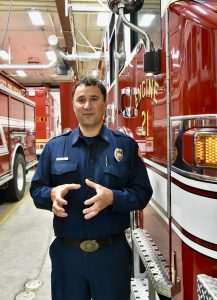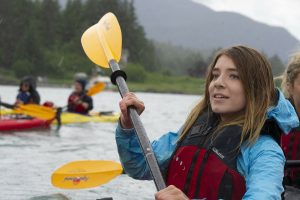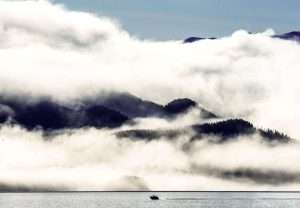Get to Know Sealaska Shareholder and CCFR Captain Jayme Johns
Capital City Fire Rescue (CCFR) and the Juneau Unity Group partnered to incorporate formline art onto a refurbished ambulance. The Unity Group is a collaborative partnership between Juneau’s Native organizations: Sealaska, Sealaska Heritage Institute, Douglas Indian Association, Central Council of the Tlingit and Haida Indian Tribes of Alaska, Goldbelt Inc., Southeast Alaska Regional Health Consortium, Huna Totem Corp., Kootznoowoo Inc., and Tlingit and Haida Regional Housing Authority. The refurbished ambulance will be put into service in September. We caught up with front-line worker Captain Jayme Johns of CCFR ahead of the ambulance’s release.
From a young age, Sealaska shareholder and Goldbelt shareholder descendant Jayme Johns knew he was a helper. One of his high school aptitude tests suggested he pursue a career serving others, a calling that he has realized today as one of Juneau’s essential workers. Johns serves as a fire captain for Capital City Fire Rescue at Station 3, the Glacier Fire Station. He has been a full-time firefighter since 2003 after joining the force in a volunteer capacity in 1996.

“I started out as a volunteer firefighter, and through that work and the encouragement of the guys here, I decided to pursue firefighting as a full-time career,” said Johns. “When I was a kid, my mother always thought I was going to be a firefighter when I grew up, and here I am, 23 years in, a CCFR captain. My mom was right, and she is extremely proud of me.”
Johns advanced from his first position as a volunteer firefighter to a firefighter I/emergency medical technician (EMT) I, reaching his EMT II level within the first year. He then graduated to firefighter II/EMT III, with more specialized skills and training including leadership and communication skills, building upon his previous training as a volunteer firefighter and firefighter I/EMT I. Eventually, he progressed to a new position as engineer, driving the firetrucks themselves, where he was responsible for the functioning of the engine both on- and off-scene. Johns was promoted to captain in 2018.
“I love being a captain and working with my crew; seeing what accomplishments they achieve,” said Johns. “My whole goal for these guys is that they want to come back to work every shift and enjoy coming to work with me. It’s incredible to see their growth and advancement in their careers, especially with the newer generation of firefighters. I love seeing how they pursue things and challenge themselves. It brings back memories of when I first started with CCFR.”
In his work as a captain, Johns is responsible for overseeing a crew of six each shift. What that means today looks very different than what it looked like prior to the COVID-19 pandemic.

“As a fire captain, my sole responsibility is my crew,” said Johns. “But with the COVID-19 virus, things have changed. Being essential workers, if one of us got sick, we would all have to quarantine, which would drastically impact the level of service we provide to the community. CCFR is already working overtime to fill slots and keep the community covered, and it would hit the department hard if one of our crews got sick or had to quarantine. It does happen — we’ve read about entire crews that have been taken out of commission, either by coming down with COVID-19 or through needing to quarantine due to exposure. Here in Juneau, we only have 30 or 40 full-time firefighters, so if one crew of six went down, the whole city would feel the effects.”
This shift in mindset and operating procedure has affected more than just the way the crew works. As a captain, Johns supervises his team, overseeing the scene of accidents and fires and ensuring the safety of both crew and patients, but he is also responsible for providing firefighting training. These trainings, which encompass specialized skills such as backcountry, ice, swift water, and confined space rescue, usually take place in large groups each fall.
“Unfortunately, trainings have shifted majorly this year because of the pandemic,” said Johns. “We normally meet in groups and do a lot of hands-on practice with the trainees as a team, but that just isn’t happening right now. This year, trainings are either individual or online, and the number of trainings we can teach successfully has definitely decreased. The change in format is challenging for those learning new skills, but also for me as a captain, because I’m not able to see the strengths and weaknesses of the group as whole.”
Johns takes pride in the skills of his crew, and the attitude of teamwork and partnership that is ingrained into the culture at CCFR. He values the sense of community and duty that being a firefighter has taught him. Learning of the partnership between the Unity Group and CCFR to create a new formline ambulance evoked a different type of pride and sense of community for Johns.

“I’m excited to see my Tlingit culture represented each day at the fire station — it’s awesome this project was possible,” said Johns. “I have high hopes that this new ambulance might inspire a new generation of Alaska Native firefighters.”
Johns would like to encourage young Alaska Native people to consider CCFR as they think about their future careers. “I challenge young Alaska Native adults to come out and volunteer. The great thing about the volunteer firefighter program is that you can try it out without committing to anything full-time, because it’s not for everyone. Starting out as a volunteer like I did can help you see if it’s your calling. For me, it was, and I found it important to give back to the community, being Alaska Native, and being born and raised here. I hope my work as a fire captain helps make a positive change here in Juneau.”
Johns is Tlingit, Raven, Coho and his Tlingit name is Daanax.ils’eik.
CCFR Assistant Fire Chief Chad Cameron says the Juneau ambulance project has captured the attention of fire departments in Alaska and beyond. The Klawock fire department has two new ambulances and is interested in incorporating formline art on the new emergency vehicles.
Click here to learn more about joining Capital City Fire Rescue as a volunteer or staff. To learn more about Capital City Fire Rescue visit https://beta.juneau.org/fire.
Take a glimpse inside Glacier Fire Station 3 and recent CCFR training here.
About the Ambulance
Both sides of the ambulance feature Tlingit formline art by artists Mary Goddard and Crystal Worl. The hand represents healing, and in the Northwest Coast culture is known as the Healing Hand. In the Tlingit culture, there is a belief that everything is interconnected, which greatly impacts our health. This is represented by the Spirit Face. In Tlingit culture, balance is a common theme — to keep the ambulance balanced, one side represents day and the other, night. The sun and the stars illustrate the bright hope and help that our EMTs and first responders offer when responding to calls.









 Previous
Previous